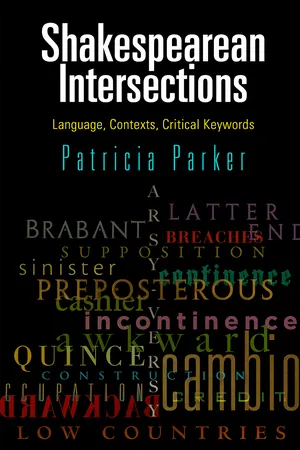
- 424 pages
- English
- ePUB (mobile friendly)
- Available on iOS & Android
About This Book
What does the keyword "continence" in Love's Labor's Lost reveal about geopolitical boundaries and their breaching? What can we learn from the contemporary identification of the "quince" with weddings that is crucial for A Midsummer Night's Dream? How does the evocation of Spanish-occupied "Brabant" in Othello resonate with contemporary geopolitical contexts, wordplay on "Low Countries, " and fears of sexual/territorial "occupation"? How does "supposes" connote not only sexual submission in The Taming of the Shrew but also the transvestite practice of boys playing women, and what does it mean for the dramatic recognition scene in Cymbeline?With dazzling wit and erudition, Patricia Parker explores these and other critical keywords to reveal how they provide a lens for interpreting the language, contexts, and preoccupations of Shakespeare's plays. In doing so, she probes classical and historical sources, theatrical performance practices, geopolitical interrelations, hierarchies of race, gender, and class, and the multiple significances of "preposterousness, " including reversals of high and low, male and female, Latinate and vulgar, "sinister" or backward writing, and latter ends both bodily and dramatic.Providing innovative and interdisciplinary perspectives on Shakespeare, from early to late and across dramatic genres, Parker's deeply evocative readings demonstrate how easy-to-overlook textual or semantic details reverberate within and beyond the Shakespearean text, and suggest that the boundary between language and context is an incontinent divide.
Frequently asked questions
Information
Table of contents
- Cover
- Half title
- Title
- Copyright
- Dedication
- Contents
- List of Illustrations
- Introduction
- Chapter 1. Preposterous Reversals, Latter Ends: Language and Contexts in Love’s Labor’s Lost
- Chapter 2. Mastering Bianca, Preposterous Constructions, and Wanton Supposes: The Taming of the Shrew
- Chapter 3. Multilingual Quinces and A Midsummer Night’s Dream: Visual Contexts, Carpenters’ Coigns, Athenian Weddings
- Chapter 4. “No Sinister Nor No Awkward Claim”: Theatrical Contexts and Preposterous Recalls in Henry V
- Chapter 5. What’s in a Name? Brabant and the Global Contexts of Othello
- Chapter 6. Intimations of Ganymede in Cymbeline
- Notes
- Index
- Acknowledgments